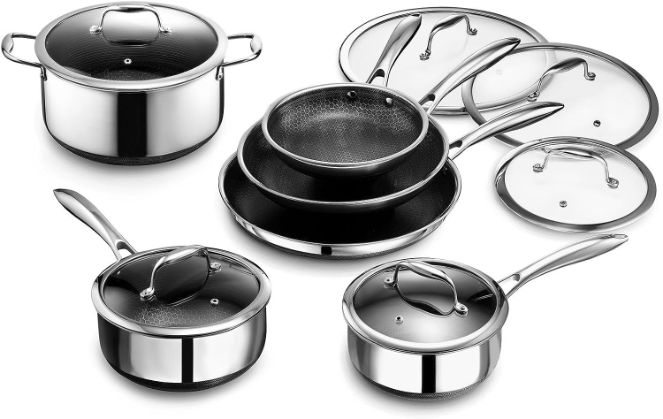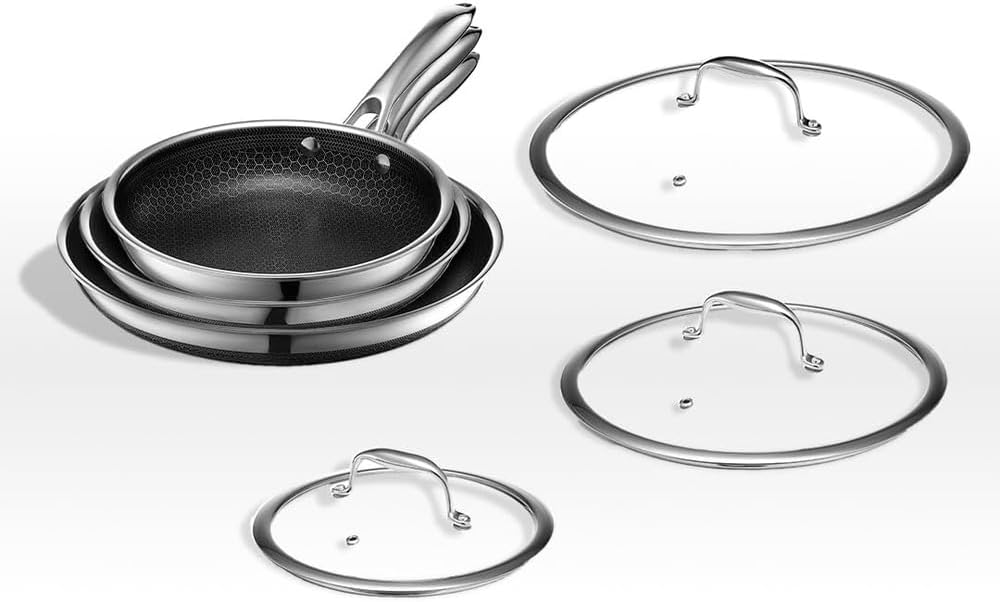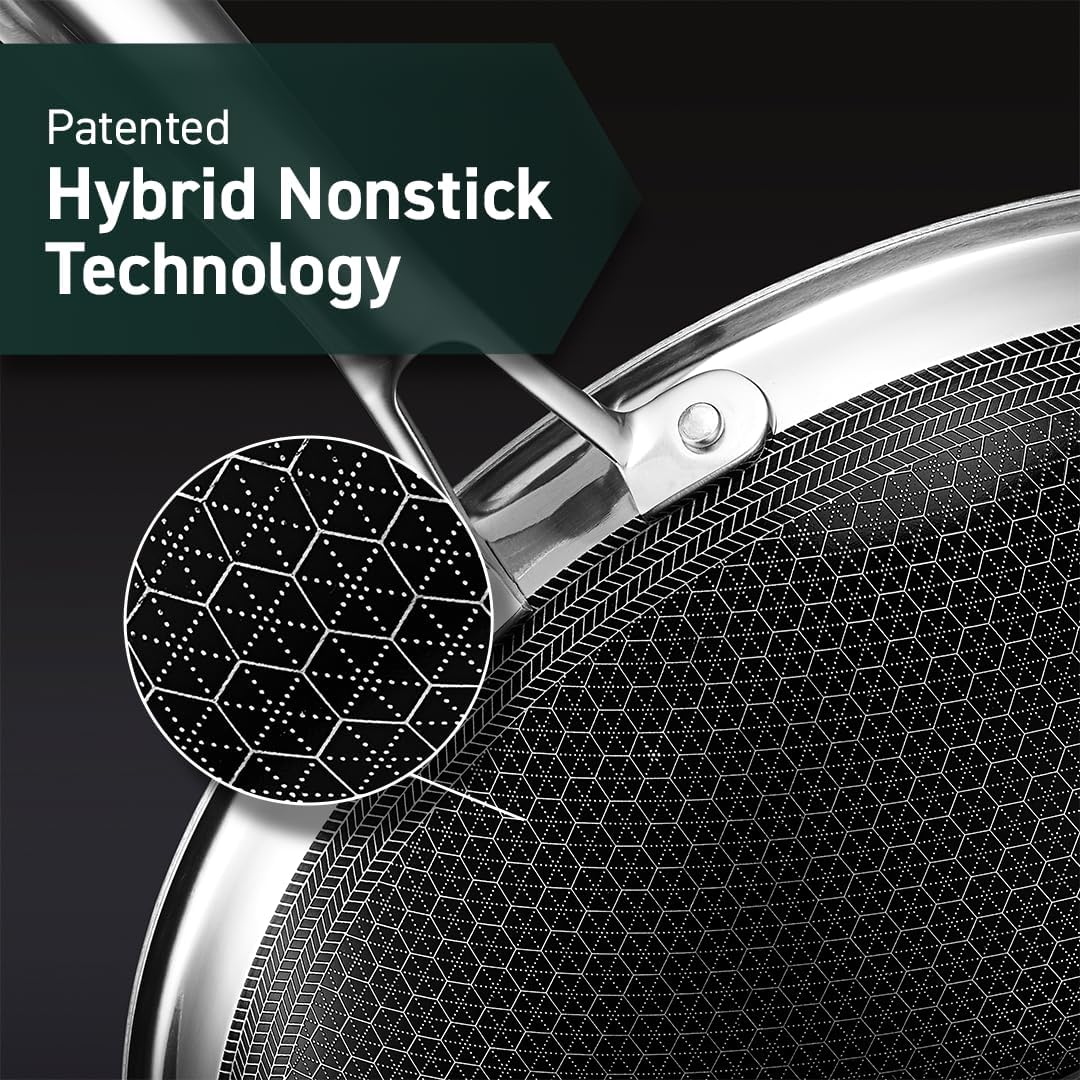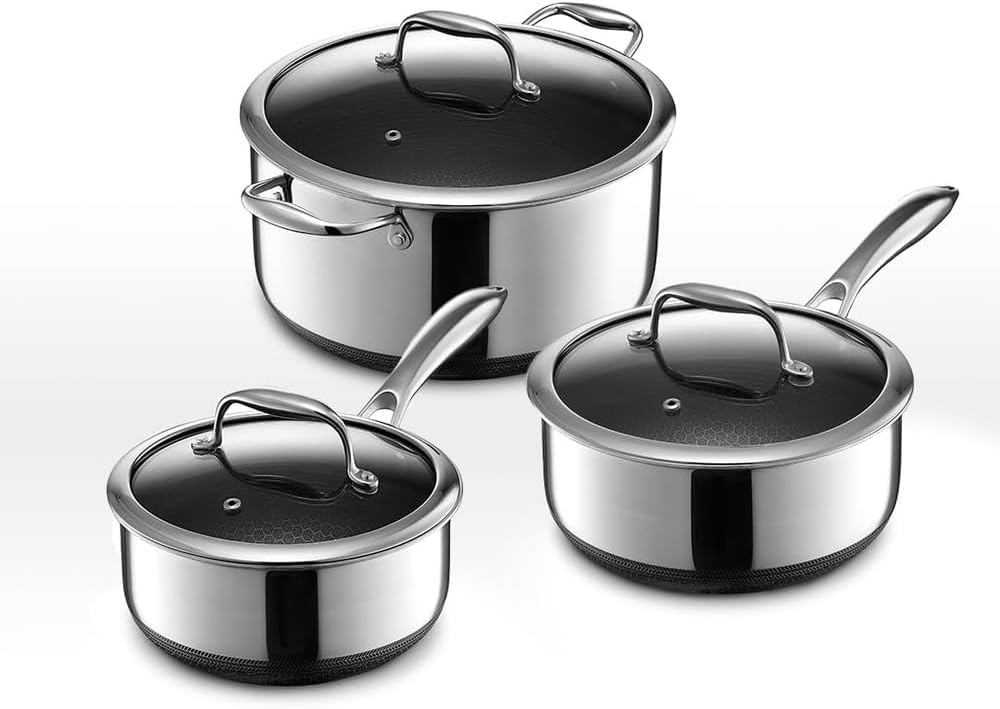
Nonstick and stainless steel skillets are essential culinary tools. Each type of cookware has advantages and disadvantages. HexClad is a unique hybrid cookware with a natural nonstick surface that will not chip or wear out like regular nonstick. It, like stainless steel and cast iron, generates scorching surface heat.
If these lofty claims hold, the HexClad Cookware frying pan could be all you need. To put HexClad‘s marketing to the test, I used a 10-inch skillet for a month and cooked alongside stainless steel and nonstick skillets. Check out the Hexclad wok work to see if it’s a one-pan-fits-all cookware idea.
The HexClad didn’t sear like a stainless steel skillet but outperformed the other pans I tried. It shouldn’t replace all your stovetop pots but can be a good addition for the right chef.
What is HexClad Cookware?
It is the first cookware line that mixes PFOA-free nonstick with honeycomb-shaped laser-etched stainless steel. Amid the hexagonal honeycomb formations, the stainless steel lines rise slightly, and the nonstick lines fall. The steel protects the stick interior from metal instruments and typical wear and tear while allowing the surface heat to reach extremely high temperatures for cooking steaks.
HexClad, like other cookware, contains a metal core that is light and efficient at transporting heat. A 10-inch HexClad pan weighs 3 pounds, heavier than a standard nonstick or three-ply stainless steel skillet, which weighs less than 2 pounds.
They make a variety of cookware, but I just tried the frying pan because it is the most commonly used item. The sturdy pan features a circular handle that is comfortable to grasp. It will not break if you bake it at 500 degrees F.
Key Features Of HexClad
These are the highlights if you don’t have time to read the entire Hexclad review. I discovered these things after using HexClad pots and pans for several years. During my testing, I recorded videos and took more than a dozen photographs throughout the research.
Pros:
Durability: Most nonstick cookware lasts between 2 and 5 years. However, using metal utensils to damage the coating may not last as long. HexClad’s mixed design solves this problem. The surface is neither smooth nor sticky; it contains jagged stainless steel peaks and nonstick troughs. Rub your fingers over the square lines and dots to feel the roughness.
Because of the steel points, spatulas, tongs, and forks could not touch the nonstick layer. Metal tools can be used, and the nonstick coating will remain longer.
Versatility: HexClad cooks more like nonstick cookware, but because the surface isn’t entirely smooth, it sears the meat and grabs food better than conventional nonstick pans. When it comes to cooking crispy bacon, salmon, roast chicken, and chicken cutlets, it performs similarly to stainless steel pans. The temperature remains constant, it warms up rapidly, and the effects remain consistent.
The bacon is crisp, and the chicken and steak are cooked similarly. It was also helpful for making pancakes, eggs, and vegetables. Even though it’s not as smooth as nonstick, eggs didn’t cling as long as I greased the surface well with butter or oil.
Controlling Heat: We do a fast test on each pan we examine to check how quickly and evenly it warms up. We increase the heat to high and pour in two cups of water. HexClad performed an outstanding job. The bubbles were uniformly distributed throughout the cooking surface, indicating that it heated up evenly, and it was one of the pans that boiled water the quickest.
The pan contained water. We removed it from the heat and placed it on the counter. After five minutes, the water in the HexClad pans reached 120°F and 102°F. Hexclad wok retains heat better than most other varieties, including Calphalon, Hestan, and All-Clad. The outcomes will demonstrate this.
Cons:
Eggs cling Without Oil: If you don’t heat the pan enough or use enough butter or oil, eggs and other delicate foods will cling. Eggs do not stick to a typical nonstick pan since it does not require much, if any, fat. That is not the case with Hexclad wok. It would be ideal if you were at least overweight.
Short Handles: The 12-inch HexClad pans feature an 8-inch-long handle. The handles of the All-Clad Nonstick are 9 inches long. Using HexClad will bring your writing closer to the heat. On the stove, the end of the handle remains calm, but it becomes heated about 2 inches past where the handle splits.
Round Handles: The round handles are attractive. However, they shifted as I flipped the pan to transfer food to a dish. If your hands are dirty or damp or you are holding a towel or pot holder, your grip will most likely turn.
Polished handles: The polished steel handles make it difficult to conceal smudges and fingerprints. You’ll need to polish the handle frequently to keep it looking fresh.
Price: Hexclad wok is significantly more costly than most other nonstick options on the market. The higher price is justified because it is more functional and will last longer.

Hexclad Review: All You Need to Know Before Buying One!
How We Scored Hexclad Review: Cookware to Think About
The factors we evaluated while rating Hexclad are essential when purchasing nonstick cookware:
- Heater efficiency
- Durability
- Nonstick properties
- Design
- Simple to clean
- Price
- Warranty
Hexclad has been graded in each category as well as overall.
We tested the Hexclad wok skillet and recommend purchasing simply the skillet, griddle, or “wok” if you’re not using it as a high-heat wok but rather as a deep skillet or chef’s pan.
Although Hexclad is a hybrid cookware, its most significant disadvantage is its nonstick coating. Unlike clad stainless, high heat is not permitted. A nonstick pan requires oil or butter to keep food from sticking.
You’ll be happy with Hexclad’s performance if you consider it as a more durable nonstick skillet rather than a clad stainless pan that doesn’t stick.
Heater Performance
We tested it because we generally use a 12-inch skillet. We tried the pan for two weeks to evaluate how it worked, cleaned, and held up.
Without the lid, the 12-inch skillet weighs 4 pounds. That may appear to be a lot of weight, but the pan’s excellent heating performance is owing to its importance. A pan, especially a clad stainless pan, requires cooking volume evenly and retaining heat.
Hexclad recommended seasoning the pan with oil and heating it on low heat for a few minutes before using it. As previously said, this prevents stickiness, but we don’t understand the science and are unsure whether it works.
In a side-by-side comparison, Hexclad boiled water 15 seconds faster than All-Clad D3. Surprisingly, we retested and discovered that the Hexclad pan warms somewhat faster than the All-Clad D3.
Heat retention was verified by pouring the water and drying the pans on the burners. Although this was not a scientific test, the heat retention of the Hexclad and All-Clad D3 skillets was comparable. We cooked using oil or butter, as directed by Hexclad wok no bare pans.
To put the Hexclad skillet to the test, we prepared pancakes, cheese omelettes, seared burgers and chicken breasts, and sautéed broccoli, carrots, and cauliflower. Seared chicken breast in a Hexclad pan
We used low to medium heat for all jobs since we read online that nonstick properties fade at medium heat (and, in our experience, aren’t great at medium heat).
Hexclad Costco containing PTFE is oven-safe to 500F (a stovetop burner on high can quickly reach 500F), but severe heat destroys the nonstick coating.
All-Clad admits that because their clad stainless cookware warms rapidly and evenly, it does not require high heat. This was also true with Hexclad.
High heat with clad steel won’t hurt but will ruin a nonstick or Hexclad pan. Because heat damage accumulates, excessive heat will eventually destroy your nonstick pan. Depending on how hot your burners go, even medium heat can ruin it.
Still, the Hexclad skillet cooked quickly and evenly at low and medium heat, akin to an All-Clad D3 skillet or a high-end cast aluminium nonstick pan like All-Clad or ScanPan. It was quicker and more consistent than D3. Everything was evenly and pleasantly browned. The pancakes turned out perfectly golden brown.
We like to sear steak at high temperatures rather than low temperatures, so don’t be deceived by Hexclad tutorials on YouTube. High heat is required to sear a steak or burger; hence, cast iron, carbon steel, or extremely heavy-clad stainless, such as the Demeyere Proline skillet, is ideal. In certain movies, you can see the intense heat under the pan if you look attentively.
The heating efficacy of Hexclad is otherwise satisfactory. It cooks just as well as the All-Clad D3, but if you like a firm sear, choose a different pan or risk ruining your Hexclad and creating a sticky mess.

Durability
Hexclad Pan with Metal Spatula
Durability is rugged to define. Hexclad cookware is more durable than nonstick. Hexclad may be used with metal utensils since the stainless steel lattice over the PTFE coating avoids scratches. Metal utensils with broad blades will not penetrate the stainless surface. As a result, they’re OK.
As a result, Hexclad is more durable than traditional nonstick cookware. It is substantially less sturdy than clad steel cooking surfaces. High heat is rarely required with covered stainless, although it may be used safely. You may use steel cutlery on clad stainless without fear of scratches, although the appearance may be off.
None of these apply to Hexclad. Never probe below the lattice with metal tools. Hexclad wok shows off an electric mixer by swiping beaters around a pan. The stainless lattice, on the other hand, conceals the nonstick coating. It’s a good thing you have metal utensils. Nonstick pans are also destroyed by high heat.
High heat is detrimental to PTFE pans such as Hexclad. The PTFE coating will wear off, despite the fact thalattice overlay hiding safe is a PTFE coating when you don’t know how worn it is. Does it emit fumes when heated? Does it emit hazardous chemicals? We have no idea, but we’d want to.
The Hexclad Costco received a medium durability grade, better than nonstick but not as excellent as clad steel. Deduct a star or two for a long-lasting pan, such as clad steel. You can give it at least one lead if you want a nonstick pan with better durability and are willing to treat it as such.
Nonstick Properties
Cooking oil or butter keeps food from sticking together. “Our pans require a bit of oil because they are hybrid,” Hexclad explains, and sticking is terrible without it. We think it’s worse than ordinary clad stainless, which will release food even without oil when it has the correct crust because we tried to fry an egg without oil in the pan.
However, no matter how well-browned the food was, Hexclad pans were poor at releasing it without oil or butter. Even though valleys” are marketed as a substantial advance in cookware design, they give a large surface area for food to adhere to. Furthermore, the uneven surface complicates cleaning. Because they require oil or butter, Hexclad pans are not nonstick.
We know it’s harsh, but most nonstick pans only stay that way for a short time after they’re new, and then you have to apply cooking oil to keep food from sticking. However, these Hexclad pans are more expensive, and we were hoping for something more extraordinary, imaginative, and nonstick.
Hexclad is not an ideal nonstick pan for cooking without utter use. These wok stainless pans will not persist for decades or resist considerable damage due to the presence of PTFE. Hexclad is an excellent choice if you want something in the middle that is easier to clean than clad steel, don’t mind using cooking oil, and can live with nonstick care and usage limits (low heat!).

Design
Look and Feel: Hexclad pans have a good look and feel. They’re helpful because they have comfortable handles, a grooved lip for drip-free pouring, shallow sides for maximum evaporation (which gives meals a gorgeous brown), and a good amount of flat cooking surfaces (9 inches in the 12-inch skillet).
Nonstick pans with lattice patterns are more durable, but they have downsides. They’re also attractive: the Hexclad wok pattern on both sides makes them stand out in your kitchen, and the exterior nonstick makes cooking stains simpler to remove and less visible against the black surface. The pans are heavy enough to heat evenly while remaining lightweight enough to handle.
Overall, an excellent design. Because glass lids are our only issue, we deduct half a point. Add half if you like them. Read on to learn more about the lids.
Induction: All Hexclad cookware is induction-compatible, giving you more options.
LidsGlass lids with small vent holes are another characteristic that some people like but TRK despises. Our vent hole is intended to relieve pressure and prevent boil-overs, but we don’t like or require it. Because glass is heavy, brittle, and commonly seen on low-quality cookware, we prefer a stainless lid with no vent holes. Pan lids are widely used to create pressure.
Water boils quicker with a lid due to pressurization. As a result, food cooks faster, even at low temperatures. With a vented lid, this is less efficient. We’d give these pans 4 or 4.5 stars for design if they had stainless or unvented glass lids.
Hexclad handles: Their handles are well-shaped and comfortable. They receive 4.5 stars. The 12-inch skillet loses a point since it lacks a helpful grip. This pan is half a pound lighter than the All-Clad D3 12-inch skillet, and we believe an assist handle is necessary for this size pan. It wasn’t easy to move since I was so full of food.
Why not add a handle to the pan, similar to the 12-inch wok?
The giant 14-inch skillet and wok incorporate two short handles to address this. The concept is excellent, but we still need an assist handle for the 12-inch skillet.
Heat Settings: We wish the pans could be used at any temperature because a good steak sear is impossible to achieve on low heat. If you want a pan that can be used at any temperature, forget Hexclad (or any nonstick).
Oven safe to 500°F may mislead you into overheating these pans. You cannot, unfortunately. A stove top burner may become hotter than 500F; this is the texture you should cook a PTFE pan to (PTFE degrades even lower than 500F, at 390F, so don’t use high oven temps.
Hybrid Nonstick Design: Because it contains PTFE but is not a nonstick pan (as the term “hybrid” suggests in marketing material), we’ll let you decide if it’s a revolutionary cookware design or plain silly because we couldn’t determine—probably because we loved these pans despite their limitations.
Simple To Clean
Hexclad pans are simple to clean. This is likely the most compelling argument for including PTFE beneath a stainless lattice: to make pans simpler to clean than clad steel. It’s excellent if you don’t mind the heating limits. Lattice-covered PTFE is easier to clean than bare stainless steel, and the darker, patterned surface hides stains better than stainless steel.
When cooking, hexclad pans discolour, especially on the sides, as demonstrated here:
Discoloured Hexclad Pan: According to Hexclad wok, discolouration is frequent due to the pan’s stainless steel. Steel wool or abrasive scrubby pads can be used to remove it. Treat this pan like stainless steel (rather than nonstick). In the closer view, the most deterioration is visible on the stainless steel.
Is steel wool harmful to nonstick coatings?
It’s feasible, but why have PTFE if you won’t use it? Will steel wool or other abrasives harm the surface of the pan?
Scrubbing removed most of the discolouration, but not all, and it took a lot of effort, maybe more than you’ll want to put in, to keep your pans looking new. After this thorough scrub, we believed the pan looked like an old Teflon pan with heat and scratch damage:
Hexclad Pan After Scrubbing: The pan looked antique after steel wool cleaning.
The cleaning ease of Hexclad is varied. Hexclad is not nonstick, however. However, it is more difficult to clean than clad steel. The peaks and valleys of the Hexclad pan may trap food, mainly if you use it without oil or butter (which we do not recommend).
And employs a manufacturer-recommended abrasive scrubber! Is it truly safe?
We give clad steel cookware three stars for easy washing and nonstick cookware five stars. Hexclad wok received 3.5 ratings in this area due to the discolouration and the labour necessary to remove it (not all).
Price
Even though we loved Hexclad Costco, we gave them a mediocre pricing grade since they are expensive for Asian-made PTFE pans. ScanPan and Swiss Diamond are two more pricey nonstick options. As discussed in our ScanPan article, these pans are worth more than their nonstick longevity since they are developed with an eco-friendly mindset that Chinese cookware lacks. (The use of PTFE by ScanPan contributes to the “forever chemical” pollution of our water systems.)
Besides the stainless lattice, we’re not sure what you’re paying for because Hexclad cookware is made in Asia (Korea and China). It costs more than other Chinese-made clad stainless cookware brands like Cuisinart and Tramontina.
Hexclad cookware is cheaper than All-Clad cookware (any line) but more expensive than most other manufacturers.
Though the longevity of Hexclad is unclear, it will not survive as long as clad stainless steel cookware. Heat destroys PTFE, causing the coating to wear out like any other. We recommend comparing costs to other nonstick manufacturers because these pans contain PTFE.
Nonstick cookware produced in Asia is expensive. If you like the look and don’t mind spending money, Hexclad could be worth it. We recommend practically any good-clad stainless steel brand if you’re on a tight budget and looking for long-lasting cookware. A good nonstick pan may be found for less money. Hexclad is “hybrid” cookware, which means it’s not nonstick (thus, the odd review).
Warranty
Hexclad cookware comes with a limited lifetime guarantee. Nonetheless, several consumers have expressed dissatisfaction that they must pay to ship their damaged pan to them for repair and that the warranty only covers manufacturing problems. As a result, the contract is typical for nonstick cookware: it sounds great, but you have to prove you didn’t abuse the pan.
Within 30 days of purchase, Hexclad’s 30-day, no-questions-asked refund policy allows you to return cookware for a full refund. Unfortunately, return shipping is not free. This is why, if you have Amazon Prime, you may choose to purchase there. Amazon covers return shipping for cookware. Check Amazon’s pricing first since they may be higher or lower than Hexclad.com‘s.

What About Hexclad Wok
Although Hexclad wok works are attractive, they are unsuited for conventional Asian stir-frying. High heat is recommended in this wok cooking method, however. However, cookware should not be used with high heat. High heat is harmful because it causes items to adhere together and destroys the PTFE coating, potentially releasing toxic toxins.
However, if you consider these “works” to be chefs or Essential pans, which they are, they may be used for much more. Consider these large skillets; you may discover they are one of the most useful pans in your kitchen.
The 14-inch has a cover. However, the 12-inch is available with or without. The 14-inch top features a dome and is partially composed of stainless steel, but the 12-inch body has a crown and is entirely glass.
If you buy the pan to use as a chef’s pan, receive the lid. The 14-inch cover costs around $70, while the 12-inch cap costs approximately $50.
Comparison Chart Of HexClad vs. Anolon X:
| HexClad | Anolon X | |
| Base Construction | 3-ply stainless steel | Hard-anodized aluminium |
| Cooking Surface Material | Hybrid of stainless steel and nonstick | Stainless steel mesh on top of nonstick coating |
| Cooking Surface Design | Hexagons | X’s that form a diamond pattern |
| Handles | Rounded, polished steel | Flat, polished steel |
| Thickness | 3 mm | 2.5 mm |
| Weight (10-Inch Fry Pan) | 2.5 pounds | 2.3 pounds |
| Time to Boil (2 Cups)* | 2 minutes and 30 seconds | 2 minutes and 22 seconds |
| Water Temperature After 10 Minutes* | 102°F | 96°F |
| Oven-Safe Temperature | Up to 500°F | Up to 500°F |
| Induction-Compatible | Yes | Yes |
| Metal Utensil Safe | Yes | Yes |
| Dishwasher Safe | Yes | No |
| Product Offerings | 22 sets and individual pieces | 15 sets and individual pieces |
| Where It’s Made | China | United States, Thailand, Italy, and China |
| Company History | Introduced in the U.S. in 2016 | Anolon launched in 1989, but Anolon X was released in 2021 |
| Price | $$$$ (HexClad.com, Amazon) | $$$ (Anolon.com, Amazon) |
| Top Reasons to Buy | Versatility (from searing to flipping eggs) | Flush rivets, oil stays in the centre |
| Top Reasons to NOT Buy | Price: Costs as much as premium stainless steel or copper cookware | Stickier than HexClad, the steel X pattern doesn’t protect the sides |
| More Details | HexClad Review | Anolon Review |
Conclusion
Finally, HexClad costco is a dependable and distinct solution for modernizing kitchen essentials. Its superb nonstick perf, perfect heat distribution, and robust construction make cooking more fun.
Higher initial investment than traditional cookware, but superior quality and long-term advantages. The HexClad Wok complements every kitchen, whether professional or home cook.
FAQs
What is the composition of HexClad cookware Costco?
Hexclad wok was one of the first producers to employ an interconnected hexagonal stainless steel/nonstick cook no-cook nonstick design consisting of a magnetic steel outer layer, an aluminium core, and a revolutionary hybrid surface with laser-etched high-quality stainless steel peaks and PFOA-free nonstick majority of nonstick coat nonstick constructed of the non-hazardous polytetrafluoroethylene (PTFE). The sole PTFE warning is that it should not be heated over 500°F.
How many sets and pots does Hexclad wok offer?
HexClad features a single cookware range that includes multi-piece sets and individual pans. Browse HexClad.com for the most recent offerings:
Set of 13 Lidded Cookware
- 7-Piece Cookware Set with Lids and Wok
- 6-Piece Pot Set
- 14-Inch Pan with Lid
- 12-Inch Pan
- 10-Inch Pan
- 8-Inch Pan
- 12-Inch Lid
- 8-Inch Lid
- 14-Inch Wok
- 12-Inch Wok
- 12-Inch Griddle Pan
• 12″ Griddle Pan”Every piece of cookware is a stateless steel-nonstick hybrid. The handles on tempered glass lids are made of stainless steel.
Where is HexClad cookware manufactured?
HexClad is designed in Los Angeles and manufactured in China.
Is it safe to use HexClad pans in the oven?
HexClad pans are oven-safe to 500°F. Bake the tempered glass lids at 300°F.
Are HexClad pots and pans dishwasher safe?
HexClad cookware and lids are dishwasher safe for easy cleanup. Hand-washing excellent cookware like this is something I recommend. Steam, harsh detergents, and high temperatures can all shorten the life of a dishwasher.






